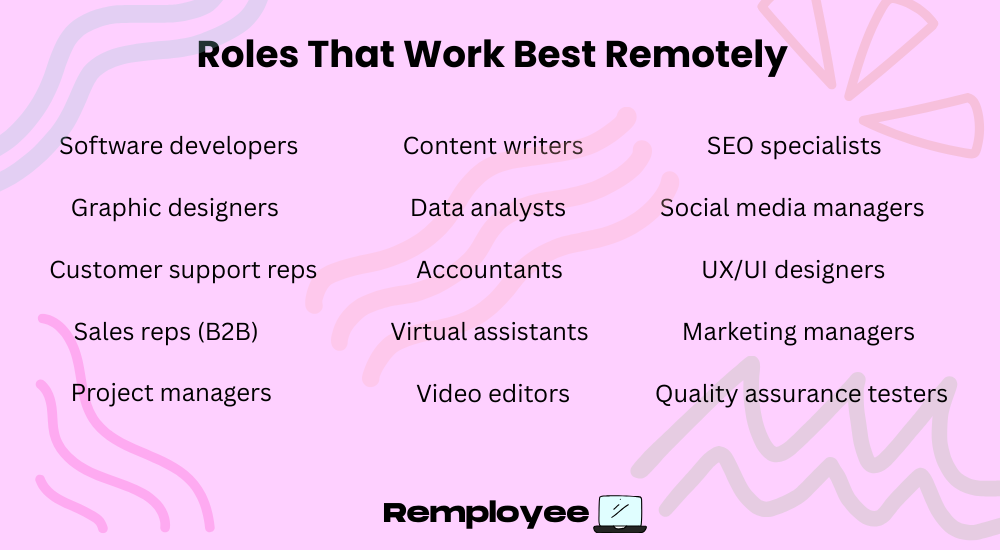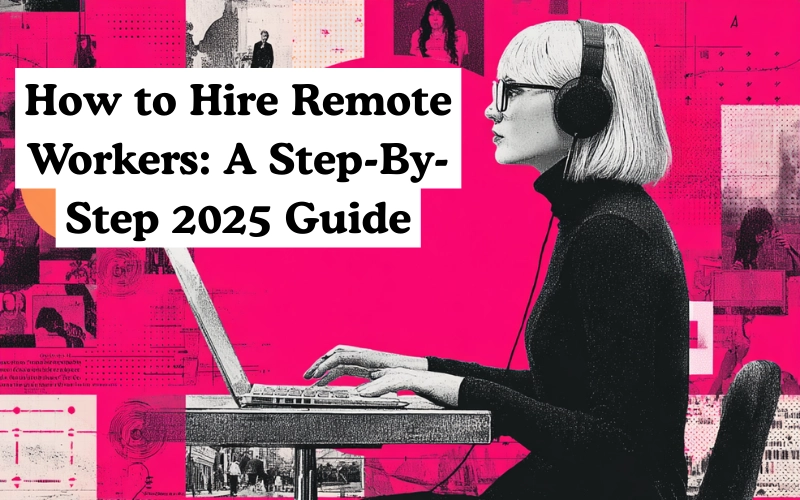Remote hiring in 2025 feels like dating with a blindfold on.
You’re swiping through resumes from people you’ll never meet in person.
Trusting your gut on a pixelated Zoom call.
And somehow, you’re supposed to build a killer team from this chaos.
I’ve helped CEO’s and managers hire 100+ remote workers over the past three years. Some were home runs. Others? Let’s say I learned expensive lessons about why “seems nice on video” doesn’t equal “can actually do the job.”
This guide walks you through exactly what works (the real process that’ll save you from my mistakes).
Should You Hire Remote Workers?
Yes, or you should at least consider it. The very act of hiring remotely opens access to wider talent pools and diverse perspectives.
You’re no longer competing for the three decent developers in your city. You’re picking from thousands globally. That senior engineer who costs $180K in San Francisco? She’s $70K in Eastern Europe. Same skills. Better work-life balance. Happier employee.
Obviously, remote hiring isn’t for every role or every company, but dismissing it outright could mean overlooking opportunities for innovation and growth.
You need to weigh not just productivity gains, but also the cultural shifts that come with distributed teams.
What Are the Pros and Cons of Hiring Remote Employees?
According to Buffer’s 2024 State of Remote Work report, 98% of remote workers want to continue working remotely for the rest of their careers. That level of satisfaction translates directly into retention rates you can’t ignore.
The real pros go deeper than happy employees though. You’re looking at 40% lower operational costs without office space, 23% higher productivity according to Stanford research, and access to specialized talent regardless of geography.
The pros outweigh the cons, but only if you’re prepared for both.
The real question isn’t if remote works. It’s if you’re willing to change how you manage.
H2: Which Roles Work Best Remotely ?

Remote works brilliantly for deep work roles. The pattern is obvious once you see it. If the output is digital, the work can happen anywhere.
If it requires physical presence, tools, or face-to-face interaction with customers, remote becomes a liability.
Here are some jobs that remote workers thrive at:
- Software developers
- Content writers
- Graphic designers
- Data analysts
- Customer support reps
- Accountants
- Virtual assistants
- Project managers
- SEO specialists
- Social media managers
- UX/UI designers
- Sales reps (B2B)
- Recruiters
- Marketing managers
- Video editors
- Technical writers
- Online tutors
- Translators
- Quality assurance testers
- Business analysts
H2: Define Your Remote Hiring Goals & Budget
Start with brutal honesty about what you actually need versus what would be nice to have.
- Required skills (non-negotiable)
- Experience level (years matter less than proven results)
- Time zone coverage needed
- Budget including benefits, equipment, software
- Growth trajectory for the role
I once helped a company hire a “senior” developer because they needed experience. Turned out they needed someone hungry to prove themselves. The junior developer they hired next at half the cost outperformed three seniors combined because they actually wanted the job, not just a paycheck.
Budget 20% above base salary for tools, equipment, and unexpected costs. Remote doesn’t mean cheap. It means efficient.
Choose Your Hiring Model: Contractor, Employee, or EOR (2025)
Each model solves different problems. Pick based on your growth stage.
Hire contractors
Contractors work for quick wins. You need a website redesign. A three-month marketing campaign. One-off projects where you pay for results, not time. Zero employment overhead. They handle their own taxes. Perfect when you’re testing new roles before committing.
Hire full-time employees
If you’re hiring from within the US, then employees build your core team. They own long-term projects. They shape company culture. You control their schedule, tools, and processes. Yes, there’s payroll complexity. But you get dedication and institutional knowledge that contractors never develop.
Use an Employer of Record
EOR (Employer of Record) gives you the best of both worlds in 2025. Want a full-time developer in Poland but can’t navigate local labor laws? The EOR handles compliance, payroll, benefits. You manage the work. Costs 5-10% more than direct employment but saves months of legal setup.
Craft a Remote-First Job Description That Converts
Skip the “fast-paced environment” and “wear many hats” clichés. Remote candidates read dozens of these daily.
Lead with the actual problem you’re solving. “Our customer response time sucks and we need someone who can fix it” beats “seeking customer success specialist” every time.
Include:
- Exact salary range (not “competitive”)
- Timezone expectations
- Meeting frequency
- Specific tools you use
- Actual day-in-the-life examples
- Clear success metrics
The job description that landed my best hire ever started with: “We lose $50K monthly because our checkout flow is broken. Fix this and you’ll be our hero.” Got 200 applications in 48 hours. Quality applications from people who understood the mission.
Set Compensation, Benefits & Pay Transparency
Post your salary range or watch top talent scroll past. Remote workers have options – they won’t waste time on mystery compensation that probably disappoints.
Benefits for remote workers look different. Health insurance varies by location. Unlimited PTO sounds great until nobody takes it. Home office stipends matter more than gym memberships.
My remote benefits package:
- $2,000 home office setup budget
- $100 monthly internet/phone stipend
- 25 mandatory days off (yes, mandatory)
- Async-first culture (no 8am meetings)
- Quarterly team retreats (when budget allows)
Location-based pay is dying. If someone in Nebraska does the same work as someone in NYC, paying them differently breeds resentment. Pick a number that works for your business and stick to it.
Build a Sourcing Plan: Job Boards, Communities & Referrals
LinkedIn and Indeed are graveyards for remote positions. Everyone posts there, so everyone ignores them.
We Work Remotely and RemoteOK pull serious remote-first candidates. But the goldmine? Niche communities where your ideal candidates already hang out. Developers live on GitHub and Stack Overflow. Designers lurk in Dribbble comments. Writers hide in newsletter communities.
Employee referrals work 3x better for remote roles because remote workers know other disciplined remote workers. I pay $2,500 for successful referrals that last 6 months. Worth every penny when you skip the recruiting circus.
Post in 3-5 targeted places maximum. More isn’t better – it’s just more noise to filter.
Run Practical Skills Tests & Work Simulations
Leetcode problems don’t predict job performance. Neither do personality tests. You know what does? Doing actual work.
Pay candidates for test projects over 2 hours. I budget $250-500 depending on the role. Cheapskates who demand free work get ghosted by quality talent. The test project investment pays for itself when you avoid a bad hire.
Assess Culture Add, Values & Communication Style
“Culture fit” is code for “hire people like us.” Culture add means finding people who strengthen your weaknesses.
Watch for communication patterns during interviews. Do they ask clarifying questions or make assumptions? Can they disagree respectfully? Do they follow up when they say they will?
I learned this after hiring a brilliant developer who never asked questions. Ever. Spent weeks building features nobody wanted because he assumed he knew better. Technical skills mean nothing if communication breaks down.
The magic question: “Tell me about a time you disagreed with a decision but had to implement it anyway.” Their answer reveals everything about how they’ll handle remote work reality.
Verify Identity, Backgrounds & Right-to-Work Remotely
Three horror stories from founders I know: Hired someone using a stolen identity. Hired someone in a country where it was illegal to work for US companies. Hired someone who outsourced their job to five people.
Run basic checks:
- Government ID verification (Persona or Onfido)
- Criminal background check (if relevant)
- Employment verification
- Right-to-work status
- Actual location confirmation
Video calls with cameras on during final interviews catch most fraud. But Verifient or similar services handle the heavy lifting for $50-100 per candidate. Cheap insurance against expensive surprises.
Manage Compliance: Classification, Payroll, Tax & Data Privacy (GDPR/CCPA)
Misclassifying contractors as employees costs companies millions in penalties. The IRS doesn’t care that you didn’t know better.
Understanding employer obligations for remote employees is crucial before you make your first hire.
Gusto handles US payroll compliance brilliantly – automatically files taxes, manages state registrations, and sends you warnings before you break rules. International? Deel or Remote become mandatory unless you enjoy reading foreign tax code for fun.
Data privacy gets tricky with remote work. EU employees mean GDPR compliance. California workers trigger CCPA requirements. The solution: standardize on the strictest requirements globally. Easier to have one high standard than juggle multiple frameworks.
Don’t wing compliance. One audit ruins everything.
Prepare the Offer, Contracts, Security & Equipment/BYOD Policies
Your offer letter needs teeth for remote work. Include equipment return policies, confidentiality agreements, and IP assignment clauses that account for work happening outside your office.
BYOD (Bring Your Own Device) saves money until someone’s personal laptop with company data gets stolen from a coffee shop. I learned this the hard way – now everyone gets company equipment with MDM (Mobile Device Management) installed.
Standard equipment package:
- Laptop with security software
- Password manager (mandatory)
- VPN access
- Two-factor authentication on everything
- Clear acceptable use policy
Make the offer exciting but realistic. Overselling the role leads to quick quits when reality hits.
Onboard Remotely with a 30/60/90-Day Plan & Tool Stack
Remote onboarding without structure equals confused employees who quit within three months.
First 30 days: Learn the tools, meet the team, understand basic processes. Small wins only.
Next 30 days: Own a meaningful project with support. Show competence.
Final 30 days: Contribute independently. Prove they can handle remote autonomy.
My tool stack for remote teams:
- Slack (async communication)
- Loom (video messages)
- Notion (documentation)
- Linear (task management)
- Zoom (when sync is necessary)
Record everything during onboarding. Every process explanation, every decision framework, every “this is how we do things” conversation. New hires can rewatch instead of asking the same questions repeatedly. Your team will thank you.
Wrap Up
Remote hiring in 2025 demands different muscles than traditional recruiting.
You’re not filling desks. You’re building a distributed machine that runs on trust, clear communication, and actual results instead of face time.
Every bad remote hire taught me something expensive. Every great one proved that geography means nothing when you find the right person with the right skills and the right mindset.
Start small. Hire one remote worker correctly before scaling. Perfect your process with lower stakes. Then build the distributed team that lets you compete globally while your competitors fight over local talent.
After years of freelancing through broken systems and vague job boards, Josie built Remployee to help others find what she couldn’t at first: flexible work that feels like freedom, not chaos. She believes real jobs should fit real lives—and that thoughtful writing can be a bridge to better work. If you’re looking for permission to choose differently, Josie’s already given it.



